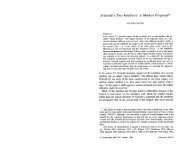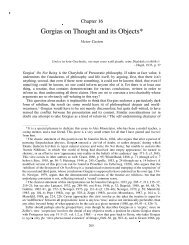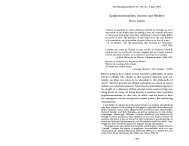Aristotle and the Problem of Intentionality. - Ancient Philosophy ...
Aristotle and the Problem of Intentionality. - Ancient Philosophy ...
Aristotle and the Problem of Intentionality. - Ancient Philosophy ...
You also want an ePaper? Increase the reach of your titles
YUMPU automatically turns print PDFs into web optimized ePapers that Google loves.
totle does not mention sensory stimulations, speaking instead more broadly<strong>of</strong> <strong>the</strong> effect produced by <strong>the</strong> sensory object. But his point is much <strong>the</strong> same,since his claim is plausible only if contextually qualified. He is concernedsolely with those powers an object has to affect <strong>the</strong> central sensory organ byacting on <strong>the</strong> peripheral sense organs in certain environmental conditions(from a certain distance, perspective, etc.) <strong>and</strong> so <strong>the</strong> powers it has to affect<strong>the</strong> central organ via sensory stimulations. A phantasma, <strong>the</strong>n, has <strong>the</strong> samepower to affect <strong>the</strong> central organ as <strong>the</strong> object would by being perceived. Butthat is just to say that <strong>the</strong> phantasma has causal powers exactly like a sensorystimulation produced by <strong>the</strong> object in those environmental conditions.A similar analysis underlies several remarks in On <strong>the</strong> Motion <strong>of</strong> Animals.<strong>Aristotle</strong> argues that behavior can occur even in <strong>the</strong> absence <strong>of</strong> <strong>the</strong>appropriate objects as a result <strong>of</strong> phantasia <strong>and</strong> thinking about such objects:Phantasia <strong>and</strong> thinking have <strong>the</strong> power <strong>of</strong> objects. For <strong>the</strong> form thought—that is, <strong>the</strong> form <strong>of</strong>what is pleasant or fearful—turns out to be in a certain way <strong>the</strong> sort <strong>of</strong> thing each <strong>of</strong> <strong>the</strong>objects is too. For this reason, people shudder <strong>and</strong> are afraid merely by thinking. (7,701b17–22)Phantasia <strong>and</strong> thought have “<strong>the</strong> power <strong>of</strong> objects” (tØn t«n pragmãtvndÊnamin), because <strong>the</strong>y have <strong>the</strong> ability to affect us <strong>the</strong> way <strong>the</strong> objectswould if perceived. This, I would suggest, is precisely what it means to have<strong>the</strong> form <strong>of</strong> <strong>the</strong> objects ‘without <strong>the</strong> matter’: <strong>the</strong> forms involved in cognitionare “similar” to <strong>the</strong> objects represented because such cognition has similarcausal powers <strong>and</strong> so can produce effects such as fear <strong>and</strong> trembling. And it isbecause phantasia <strong>and</strong> thought have such powers that <strong>the</strong>y represent suchobjects:For thought <strong>and</strong> phantasia, as was said earlier, present [prosf°rousi] <strong>the</strong> things that produce<strong>the</strong>se affects, since <strong>the</strong>y present <strong>the</strong> forms <strong>of</strong> <strong>the</strong> things that can produce [<strong>the</strong>m]. (11,703b18–20)Thought <strong>and</strong> phantasia “present” objects, even when absent, because <strong>the</strong>yinvolve <strong>the</strong> forms <strong>of</strong> such things <strong>and</strong> so possess a range <strong>of</strong> causal powers <strong>the</strong>object possesses, namely, <strong>the</strong> ability to produce certain experiences <strong>and</strong>reactions by affecting <strong>the</strong> sensory apparatus.Similarity in causal powers might seem like a ra<strong>the</strong>r subtle way <strong>of</strong> construing<strong>the</strong> notion <strong>of</strong> similarity. But <strong>Aristotle</strong>’s account <strong>of</strong> artistic representationdepends on <strong>the</strong> same underst<strong>and</strong>ing. In Politics 8.5, he distinguishesbetween representation by symbols (shme›a), on <strong>the</strong> one h<strong>and</strong>, <strong>and</strong> representationby similitudes (ımoi≈mata) <strong>and</strong> imitations (mimÆmata), on <strong>the</strong>o<strong>the</strong>r. Only music, he contends, contains similitudes <strong>of</strong> states <strong>of</strong> character;<strong>the</strong> o<strong>the</strong>r arts contain signs <strong>of</strong> character at best (1340a18–35; cf. Prob. 19.29,920a3–7). Now he cannot mean that rhythms <strong>and</strong> melodies sound like states<strong>of</strong> character, since states <strong>of</strong> character do not make any sound <strong>the</strong>mselves. Norcan he mean that music sounds like <strong>the</strong> external manifestations <strong>of</strong> character,since that is just what <strong>the</strong> o<strong>the</strong>r arts do in his opinion: <strong>the</strong>y portray signs <strong>of</strong>character in gesture <strong>and</strong> action. 72 Ra<strong>the</strong>r, rhythms <strong>and</strong> melodies are similar tostates <strong>of</strong> character in that <strong>the</strong>y can have <strong>the</strong> same sorts <strong>of</strong> effect on a listeneras states <strong>of</strong> character do. The idea is that Beethoven’s Eroica can representNapoleon’s bravery ins<strong>of</strong>ar as both are able to arouse <strong>the</strong> same reaction.More generally, <strong>Aristotle</strong> explains falsehood in both artistic <strong>and</strong> mentalrepresentations through <strong>the</strong> divergence <strong>of</strong> cause <strong>and</strong> content. In Metaphysics5.29, he says that scene-paintings <strong>and</strong> dreams are both “something, but notwhat <strong>the</strong>y produce a phantasia <strong>of</strong>” (1024b23–24) <strong>and</strong> so can be called false.They produce mental states that are not about <strong>the</strong>mselves, but somethingelse, thus splitting content from cause. The resulting states will <strong>of</strong>ten befalse, <strong>and</strong> so <strong>the</strong>ir causes—<strong>the</strong> scene-painting <strong>and</strong> <strong>the</strong> dream—can be called‘false’ by synecdoche.VI. Objections to <strong>Aristotle</strong>’s AccountThis sort <strong>of</strong> <strong>the</strong>ory immediately gives rise to a number <strong>of</strong> objections. I willcanvass <strong>the</strong> three most important kinds <strong>and</strong> briefly consider <strong>the</strong> responsesavailable to <strong>Aristotle</strong>.1. A fairly common assumption is that <strong>Aristotle</strong>’s <strong>the</strong>ory <strong>of</strong> phantasiainvolves awareness in ways that make it unacceptable as an solutionto <strong>the</strong> problem <strong>of</strong> intentionality. His <strong>the</strong>ory is <strong>of</strong>ten taken to be animagistic <strong>the</strong>ory, where phantasmata are <strong>the</strong>mselves objects <strong>of</strong>awareness—on <strong>the</strong> most common view, mental images which pass,so to speak, before <strong>the</strong> mind’s eye. 73 But it is implausible to thinkwe view mental images in each mental act that is supposed to beaccompanied by phantasia (that is, in virtually all <strong>of</strong> <strong>the</strong>m). Worsestill, it seems to commit him to a dubious metaphysics <strong>of</strong> mind,72 Compare Xenophon Memorabilia 3.10.3–5, where Socrates discusses how painting imitatesstates <strong>of</strong> character: when <strong>the</strong> painter Parrhasius objects that <strong>the</strong> soul’s charactercannot be imitated in painting because it is not visible (3.10.3), Socrates insists that ourattitudes, feelings, <strong>and</strong> character traits “show through” our face <strong>and</strong> gesticulations moregenerally (3.10.4) <strong>and</strong> this can be imitated visually (3.10.4–5). <strong>Aristotle</strong> agrees here withParrhasius against Socrates: painting cannot imitate something invisible; <strong>and</strong> <strong>the</strong> imitation<strong>of</strong> facial expression <strong>and</strong> gesture provides nothing more than <strong>the</strong> signs <strong>of</strong> character.73 This is especially common in translations <strong>and</strong> commentaries: G. R. T. Ross 1906; Hicks1907; Smith 1931; Hett 1936; W. D. Ross 1955 <strong>and</strong> 1961; Hamlyn 1968; Sorabji 1972a;Lawson-Tancred 1986. Beare 1908 <strong>and</strong> Gallop 1990 are exceptions to this trend,translating ‘phantasma’ as presentation <strong>and</strong> appearance, respectively. But to <strong>the</strong> extentthat <strong>the</strong>ir language carries connotations <strong>of</strong> conscious experience, <strong>the</strong>y are still too strong.This becomes especially clear in Beare’s discussion <strong>of</strong> phantasia (1906, 290–325), whichinsists on distinguishing phantasmata from <strong>the</strong> changes in <strong>the</strong> bloodstream, arguing thatphantasmata are objects <strong>of</strong> experience produced by <strong>the</strong>se changes. But this distinction isfictitious, given that <strong>Aristotle</strong> identifies phantasia as such a change (see pp. 259–60above).278 VICTOR CASTONARISTOTLE AND THE PROBLEM OF INTENTIONALITY 279





